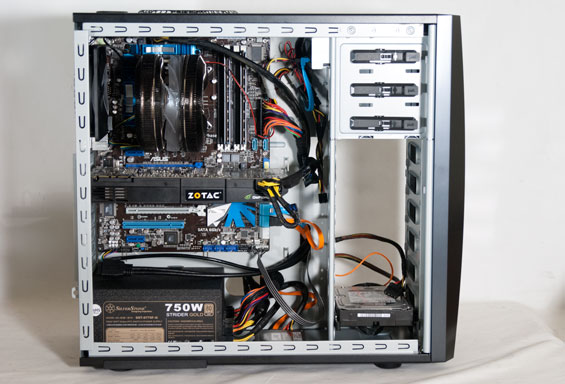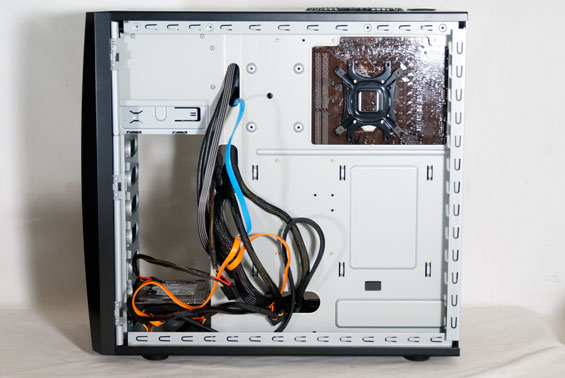Antec Three Hundred Two: Stay Cool, Budget Enthusiasts
by Dustin Sklavos on January 24, 2012 7:00 AM EST- Posted in
- Cases/Cooling/PSUs
- Antec
- mid-tower
Assembling the Antec Three Hundred Two
Given that the Antec Three Hundred Two is a fairly simple and staid affair to begin with, it stands to reason assembly would be just as simple and staid. That's mostly true. It's not as easy to put together as something from Corsair might be (currently my standard for ease of build), but it's close enough.
Antec graciously has four motherboard mounts already in place, something Cooler Master couldn't be bothered to include in an enclosure four times as expensive, and once again it's a small touch but it's a welcome one that speeds up the assembly. Where things do go a little bit south is in the wiring for the two Antec TwoCool fans that are included; their fan controllers are both externally accessible on the back of the enclosure, but the 140mm fan requires a four-pin molex connector while the 120mm fan's three-pin cable is too short to actually reach the fan header on the motherboard. As a result I had to use an adaptor cable I had laying around to actually wire the rear fan. Obviously, choice of motherboard plays a role here, so YMMV.

Nearly everything else after that point was smooth sailing. The toolless rails that Antec includes for mounting 3.5" drives are slick pieces of engineering; they slot into the screw holes on the drive, but you can actually pick up the drive by the rail and it won't fall off. 5.25" drives also benefit from a toolless locking mechanism that's among the best I've seen in the enclosures I've tested, feeling remarkably secure despite only locking in on one side.
The two places the assembly got at all hung up were the 2.5" drive mount on the bottom of the enclosure, and the metal extrusion from the motherboard tray that holds the power supply in place. I'm still not a fan of having to screw a 2.5" drive into the bottom of a case, and there's just no good way to orient it. If you face the drive's ports to the open side of the case, there's barely enough space to get a power cable in there, much less a SATA cable. If you face the drive's ports to the back of the case, there's no cutout in the tray to route the cables and you have to feel them out.

Mounting the power supply was a bit of an ordeal until I just grabbed a pair of pliers and bent the metal extrusion upward. It took some pressure off the power supply, but also allowed me to fit the thing in there to begin with. Problem solved. Again, component selection could help here; our SilverStone Strider 750W PSU is by no means massive, but it is 180mm while other PSUs are only 160mm.

Wiring everything up after all of this was mostly a breeze, though the Three Hundred Two would've benefitted from slightly bigger routing holes in the motherboard tray. They're rounded off to make things safe, but they could stand to be larger. That said, most of the complaints in assembly are minor; the Three Hundred Two comes together quite well, and getting the back panel on was surprisingly easy. Where assembly is concerned, the Three Hundred Two is a smart design.
















50 Comments
View All Comments
TerdFerguson - Tuesday, January 24, 2012 - link
It runs a cable from a USB3 port on the back of the machine.Ammaross - Tuesday, January 24, 2012 - link
"It runs a cable from a USB3 port on the back of the machine."Which, NOTE TO ARTICLE AUTHOR, is an excellent use of those water-cooling holes in the back of cases. :)
DanNeely - Tuesday, January 24, 2012 - link
I'd be more inclined to agree if it wasn't for 20-30% of reviews being 1 or 2 egg wasn't the norm for almost all devices like that. That many unhappy customers means that something is definitely not being done right.bill4 - Wednesday, January 25, 2012 - link
Well why dont you just look at the reviews? There's only 12 of them.It appears most of the poor reviews are whining that it doesnt add a USB 3.0 port it just reroutes from the back. Well DUH. The other thing is people whining that the card readers are only USB 2.0.
Damn, Americans are whiny. If people focused 1/10 their energy on what our govt is doing as they do whining about corporations and products, we might be ok in this country.
justaviking - Tuesday, January 24, 2012 - link
"but anything sound of 40C"I expect you meant to say "anything SOUTH of 40C"
Peroxyde - Tuesday, January 24, 2012 - link
And how about ""anything below 40C"It's shorter and it says exactly what it means. Why use convoluted words which, in addition, could be misleading. South is interpreted differently between habitants in Northern and Southern hemispheres.
justaviking - Tuesday, January 24, 2012 - link
What am I missing? Airflow is airflow.Whether the flow is induced by pushing air in (which must exhaust somewhere), or by sucking air out (which much come in from somewhere), what's the difference? The two critical things are the amount of air that flows over your components, and if that air has already been warmed by flowing over other components first.
It's not like we're significantly pressurizing the case and increasing the air density.
Can someone please educate me?
Arbie - Tuesday, January 24, 2012 - link
With negative pressure - as you note - the air has to come from somewhere. It comes in through every opening in your case, no matter how small. So you get dust all over the internals. This impairs heat transfer from those elements, thus degrading the overall cooling. So you don't want it; simple as that. Why it keeps popping up as a good idea is beyond me.I don't know this case myself but imagine that it can just as well be arranged for a moderate amount of positive pressure, by changing fan directions and possibly adding filters. Or find a better-designed case. Unfortunately, not many manufacturers really think about what we need.
And the situation isn't helped by niggling about $10 more or less in price, as this article does. That's down in the noise level for people designing and building their own PCs. I probably spent $200 experimenting with fans on my last build, until I got everything just right. An extra $50 spent on getting a properly designed case (lots of input fans with removable filters) would be well worth it.
justaviking - Tuesday, January 24, 2012 - link
That makes sense.Dust coming in "randomly" from all over, rather than being forced through filters (which can be cleaned) allows more dust to accumulate on the components.
So it's less about the airflow and more about dust management. I never looked at it that way before.
Thanks.
ImSpartacus - Tuesday, January 24, 2012 - link
Don't forget that a lack of dust management can quickly come to impact long term airflow as well.While a case utilizing negative pressure might still perform adequately in reviews like this one (great review by the way!), long term performance might degrade appreciably if dust isn't regularly cleaned.